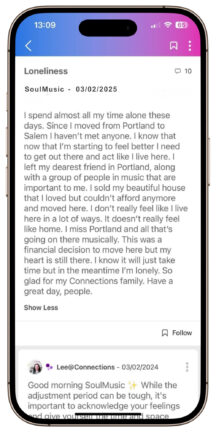
Although we are more connected than ever in today’s digital world, many people still struggle with feeling alone. Loneliness, now considered a widespread social issue, has profound implications for mental health and addiction. The U.S. Surgeon General, Vivek Murthy, issued an advisory in 2023 on the epidemic of isolation and loneliness, suggesting the need for education programs to address the many ways it impacts public health, including an increase in substance use. This crisis reaches people of every age, background, and demographic, although some populations—those lacking social support networks, seniors living alone, or individuals with mental health conditions—are especially vulnerable.
The Many Types of Loneliness
Loneliness isn’t just the absence of people. It is a complex emotional state in which individuals feel disconnected even when they are physically close to other people. People experience isolation in different ways, including:
- Physical isolation: Geographic distance from family, friends, and a supportive community.
- Emotional isolation: Feeling misunderstood or unable to share thoughts and feelings honestly.
- Social disconnection: Lacking meaningful relationships or a sense of belonging.
- Stigma-induced isolation: Withdrawing due to shame surrounding mental health issues or substance use.
The Connection Between Loneliness and Substance Use
Isolation and substance use disorder (SUD) are related, often creating a cycle in which each condition reinforces the other. Recent research reveals that nearly 80% of individuals seeking substance use treatment report frequently feeling lonely, and almost 70% report loneliness is a “serious problem” in their lives.
This issue arose during the COVID-19 pandemic, as lockdowns and social distancing became necessary for public health. People were cut off from their support networks when they needed them the most, creating the perfect conditions for increased loneliness and substance use to thrive.
Loneliness Fuels Substance Use & Deepens Isolation
When people are experiencing loneliness, they often turn to substances to self-medicate their emotional pain, create a false sense of connection or belonging, temporarily escape the negative feelings of loneliness, or cope with the anxiety produced by social isolation. Rather than providing relief, however, substance use often intensifies feelings of isolation. Individuals using substances to mitigate the impact of loneliness frequently experience:
- Relationship damage: When people use substances, they erode their trust with others, find themselves in frequent conflict, and engage in unpredictable behaviors that impact their ability to create and maintain social bonds
- Stigma and judgment: Individuals with SUD may avoid social situations, hide their behaviors, or lie about what they are doing to avoid the disapproval of others
- Shifting priorities: As SUD takes hold, individuals using substances may prioritize substance use over building or maintaining relationships
- Loss of identity: Substance use creates distance between the individual and their former social circles
Tools and Techniques to Break the Cycle
Fortunately, there are effective approaches to address the challenges of loneliness and SUD.
- Technology as a connection tool: Digital platforms have emerged as critical lifelines for isolated people. CHESS Health’s eRecovery solution, for example, includes the innovative Connections smartphone app, staffed by certified peer support specialists, which provides 24/7 forums, virtual support meetings, crisis response, and other vital resources for individuals with SUD. Clinical studies show multiple positive outcomes, including a 40-50% reduction in key relapse risk factors, a 20% increase in treatment duration, and 30-50% higher abstinence rates than control groups. With access available anytime and anywhere, this evidence-based technology helps bridge the gap for individuals dealing with isolation and SUD.
- Community engagement: When individuals feel supported, they can share their experiences without fear or judgment. Support from peers is among the most powerful tools available to individuals with SUD, helping them learn new coping skills, stay committed to recovery, and avoid relapse. Digital tools like Connections amplify the power of peer support, breaking down barriers like geography and stigma.
- Recovery communities: Joining a recovery community bolsters individuals with SUD by encouraging strong connections to others. Support meetings, whether in person or virtual, encourage sharing, often leading to opportunities to build bonds with others. Attending regularly provides structure and social interaction for people who feel alone. Through the Connections app, individuals can choose from a variety of virtual support meetings, including groups catering to specific audiences such as veterans, LGBTQIA+, and people re-entering society after incarceration.
Below is a message posted in the Community Forum within the Connections recovery support app.

Putting these tools to work helps individuals with SUD rebuild their ability to connect with others, which can reduce the appeal of substance use.
Moving Forward With a Focus on Connection
To break the cycle, it is critical to understand how isolation contributes to substance use and how substance use worsens isolation. The problem is complex, but it can be addressed by recognizing the crucial role of connection in recovery. It isn’t just a component of recovery—it sits at the foundation. Using a combination of tools and techniques, people stuck in the negative loop of substance use and isolation can find their way back to well-being, meaningful human connection, and lasting recovery.
